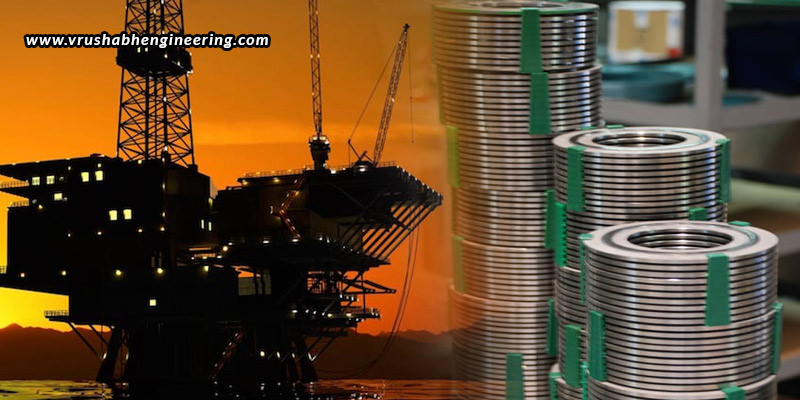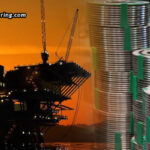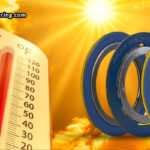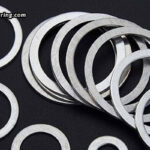When extreme conditions are the norm, such as in the oil and gas industries, power generation facilities, petrochemicals, and marine engineering, reliable and robust sealing solutions are essential. These industries have to deal with high pressures, high temperatures, and corrosion. Even a small leak in such situations can results in significant risks, production interruptions, and financial consequences. This is why it is only wise to have all such leak-possible spaces tightened with semi-metallic gaskets. Why semi-metallic? Why not only metal or only non-metal? This is because semi-metallic gaskets weave the strengths of both into one – the robustness of metals, along with the flexibility of non-metals – a unique combination. This way semi-metallic gaskets balance both durability and flexibility, making them the ideal choice for extreme conditions.
The ideal metal + non-metal combination
The dual-material construction of semi-metallic gaskets offers unique benefits.
The metallic advantage: The metallic component offers exceptional mechanical strength and pressure resistance. This helps the gasket resist deformation under loads, maintain integrity during pressure variations, and withstand thermal cycling without compromising its structural stability.
The non-metallic advantage: The non-metallic fibre is a soft material that offers flexibility to fit flange surfaces, yet guaranteeing a secure seal. Even if the surface is not perfect, the non-metallic material guarantees a tight seal. It also offers resilience against vibration, shock, and thermal expansion.
This combination ensures that semi-metallic gaskets are not overly rigid, neither are they too soft; rather, they strike an ideal balance for reliable sealing.
Material selection
With a number of options available, you should be able to choose the materials that are ideal for your industry, application, and purpose. Afterall, the effectiveness of the gasket is significantly influenced by the materials used. Suitable metals and fillers not only enhance the durability, but also improve the sealing efficiency in harsh conditions.
Metallic components: Stainless steel grades like 304, 316, and 321 are the most common metals used due to their outstanding resistance to corrosion. Materials like Inconel, Monel, or Hastelloy are preferred for their capability to endure chemical attacks in highly aggressive settings. However, if the environment is less demanding and non-corrosive, carbon steel could suffice, as it is a cost-effective alternative that does not sacrifice structural integrity.
Non-metallic components: Graphite is the most common non-metallic fibre chosen owing to its excellent heat resistance and broad chemical compatibility. PTFE is another material known for its exceptional resistance to a wide range of chemicals, and performance in low-to-medium temperature scenarios. Mica fibres can work best in industries that encounter extremely high temperatures.
Conditions where semi-metallic gaskets can shine
- High temperature
Semi-metallic gaskets are designed to withstand extreme heat. For instance, graphite can perform effectively up to 450-500°C in oxidizing settings and up to 600°C in non-oxidizing scenarios; and mica can tolerate temperatures surpassing even 900°C in specific instances! To make this even better, the metallic components can resist thermal creep and expansion, keeping the gasket in proper shape.
- High pressure
Semi-metallic gaskets can also withstand high internal pressures, such as in pipelines or pressure vessels. For instance, steel can ensure pressures up to 250 bar or more, and graphite can perform effectively well under pressures up to around 200 bar. The bolt load can be evenly distributed with such a construction, preventing localized stress and blowout.
- Chemicals and corrosion
Semi-metallic gaskets can be customized with corrosion-resistant metals like stainless steel, Hastelloy, or titanium, and fillers like PTFE. This makes them effective against not only aggressive chemicals, but also acids and alkalis. Hence, when exposed to solvents or corrosive environments, these gaskets can prevent against leakage.
- Vacuum and cryogenic conditions
Extreme conditions don’t just involve high temperatures and pressures; at times, it could also mean low temperatures or vacuum. Semi-metallic gaskets work best here too by retaining their elasticity and preventing inward buckling. This makes them best for LNG plants, aerospace systems, and cryogenic storage facilities.
- Dynamic loads and thermal cycling
There could be periodic cycles of heating and cooling, along with vibrations or varying pressures. All these inconsistent environments need semi-metallic gaskets to guarantee proper sealing. The metallic components offers the strength to withstand continuous movement, and the non-metallic components accommodate thermal expansion and contraction.
Why are semi-metallic gaskets preferred over other alternatives?
Semi-metallic gaskets are a balance of strength and flexibility. Unlike metals that are rigid, and non-metals that can wear off easily, semi-metallic gaskets offer significantly greater strength, enhanced flexibility, and resistance to blowout. They can handle all sorts of temperatures and pressures, both high and low, along with vibration and corrosion. All these features and the combination of strength and flexibility make them the preferred choice in a variety of industries, especially those where gasket failures are unacceptable. Some industries include oil and gas, petrochemical refineries, chemical processing plants, chemical reactors, power plants, aerospace, defence, marine, automotive exhausts, turbine housings, steam systems, compressors, and cryogenic storage facilities.
Installation and best practices
Only choosing the right semi-metallic gaskets for your application isn’t enough. You need to have them installed properly, while also following many other best practices, if you wish to have optimal performance.
- Prior to installation: Before installation, check the flange surface finish and flatness. Any imperfections can compromise sealing efficiency. Preparing the flange ensures that the gasket fit properly, reducing leakage risks and maintaining long-term reliability even under high-temperature and high-pressure conditions.
- Torque distribution: Even torque distribution prevents localized stress points, which ensures a uniform seal and minimizes the chances of gasket failure in demanding operating environments. It is thus essential to apply torque in the correct sequence.
- Ensure the right amount of tightness: over-tightening the gasket isn’t a good idea. While they must be tight to prevent leakage, over-tightening the bolts can crush the filler material, which reduces the gasket’s flexibility, thus affecting performance. Maintaining the right amount of tightness ensures effective sealing.
- Timely gasket replacement: It is necessary to replace the gaskets during maintenance intervals. Fresh and timely replacements ensure structural integrity, compliance with industry standards, and consistent sealing performance in even the most critical applications.
Semi-metallic gaskets have proven to be a reliable and adaptable sealing solution, especially in industries where equipment is required to operate past its limits. By combining the strength of metals with the flexibility of non-metallic fibres, these gaskets provide reliable performance in extreme temperatures, extreme pressures, and corrosive environments. Vrushabh Engineering is where you can find high-quality semi-metallic gaskets designed with advanced materials, precision engineering, and a focus on durability, delivering gaskets that ensure safety, efficiency, and consistent sealing performance across critical applications in diverse industrial sectors. Their versatility, performance capabilities, and innovative designs guarantee that they will continue to be a fundamental element of industrial sealing solutions for the foreseeable future.






